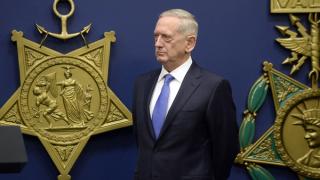US Secretary of Defence James Mattis launched a new National Defence Strategy (NDS) last Friday. That night, the US Government shut down for three days.
The convergence of these two events encapsulates a very significant trend in the United States: an increasingly dysfunctional political process is seriously affecting national security. There are serious implications for Australia's strategic outlook.
Congress has now reached a deal to reopen the Government with a stop-gap measure — known as a continuing resolution — that will fund the Government for two-and-a-half weeks. Another political stoush is likely before February 8, the next deadline. In these circumstances, the US military is operating with no certainty over its funding, hamstrung in its ability to make long-term strategic decisions.
A senior Senate staffer told the authors last year: "US politics are toxic. This is self-inflicted decline — the country may be on the verge of being ungovernable."
This is the latest in a series of own goals by the United States. A senior Senate staffer told the authors last year: "US politics are toxic. This is self-inflicted decline — the country may be on the verge of being ungovernable."
An important document for Australia
The new National Defence Strategy marks a shift in US priorities from combating terrorism to great power competition.
China and Russia, which it labels "revisionist powers", will be at the forefront of the Pentagon's thinking. Many have praised the strategy as an appropriate, if overdue, response to the deteriorating global security environment.
It is an important document for Australia, especially as it focuses on the value of burden sharing with allies and recommits to a renewed focus on the Indo-Pacific.
But, as Mr Mattis made clear in his speech launching the strategy, political gridlock in Washington could render the document redundant.
Without a regular budget, "ships will not receive the required maintenance to put to sea … aircraft will remain on the ground, their pilots not at the sharpest edge; and eventually ammunition, training and manpower will not be sufficient to deter war", he said.
It's not Trump's fault
Heightened partisanship and polarisation in Congress have already had a measurable impact on the US military. As an independent and co-equal branch of government, it is Congress that ultimately determines total annual expenditure on defence. For almost a decade, Congress has been unable to make the bipartisan compromises required to give the Pentagon predictable funding or even pass the defence budget on time.
This is an accumulated, ongoing, structural political problem for which President Trump at this stage bears minimal responsibility: had Hillary Clinton won the 2016 election, her administration would have faced the same challenges.
For almost a decade, Congress has been unable to make the bipartisan compromises required to give the Pentagon predictable funding or even pass the defence budget on time.
Consider the current intersection between US politics and the military.
Despite the launch of the National Defence Strategy, President Trump's repeated calls to expand the size of the US military, blunt warnings by Pentagon leaders about a lack of military readiness, 17 deaths last year due to two avoidable naval crashes in Asia, Republican majorities in both houses of Congress, the North Korean nuclear threat and increasingly truculent behaviour by China and Russia, Congress has not yet appropriated the money to fund President Trump's first defence budget.
While there will always be spirited debate about the size of the US defence budget, there is widespread agreement that the current process of delayed appropriations is highly inefficient.
Instead, the Pentagon has operated on a continuing resolution — agreements that fund the government based on the previous financial year's level — for at least two-and-a-half months at the start of each financial year, and sometimes seven to eight months.
In the absence of an appropriated defence budget, the Pentagon has had to weather an unrelenting series of stop-gap funding measures that offer military leaders little predictability or flexibility over spending, and then an injection of cash that must be spent within the remaining months in the financial year, before the cycle starts again.
The new norm is inefficient
Continuing resolutions are meant to be short-term measures. But they are now the governing norm, which increases the inefficiency of the government, adds to spending costs and prevents the Pentagon from moving funds into needed areas, like increased training time for naval crews or starting new research and development programs.
The National Defense Strategy acknowledges the United States has enjoyed "uncontested or dominant superiority in every operating domain" for decades, but today, "every domain is contested — air, land, sea, space, and cyberspace."
The NDS acknowledges the United States has enjoyed "uncontested or dominant superiority in every operating domain" for decades, but today, "every domain is contested — air, land, sea, space, and cyberspace."
It asserts that the US is also losing its technological edge to countries like China — a key aspect of its military power since the end of the Cold War.
Despite the scope of these global challenges and Mr Trump's hyperbole about building up the military, US defence spending is low by historical standards. Any talk of a "Reagan build-up" under Mr Trump is misplaced: The US President's proposed level of military expenditure closely resembles Obama-era spending of about 3.2 per cent of GDP, far below the 5.5-6 per cent under Mr Reagan.
The National Defence Strategy is a sober document that takes a realistic look at the deteriorating security environment. For Canberra it should provide a degree of assurance that the Pentagon is taking Australia's regional challenges seriously. But it also reveals an unwillingness to reduce the scope of its global military role. To meet its ambition, the strategy needs to be funded and political trends in the United States point in the other direction.







